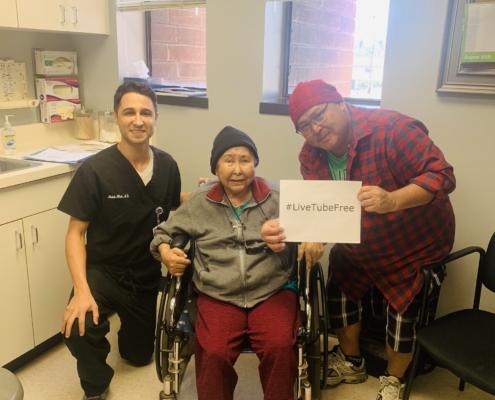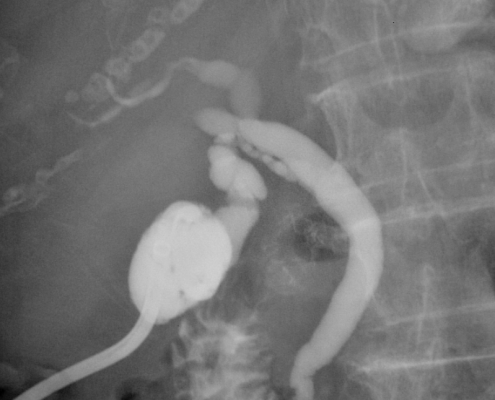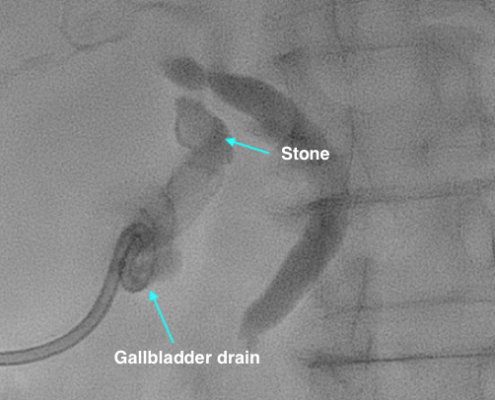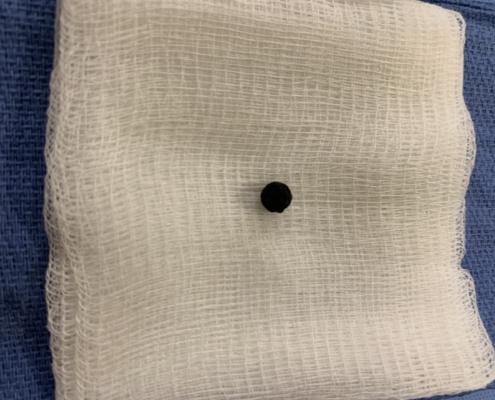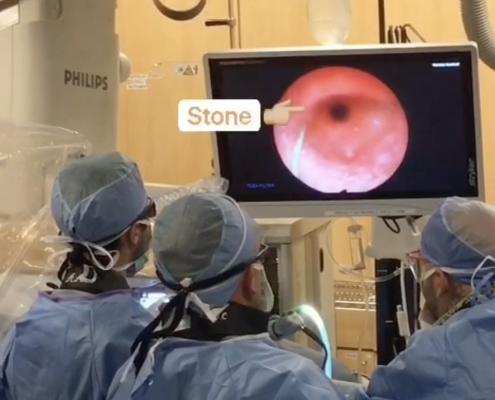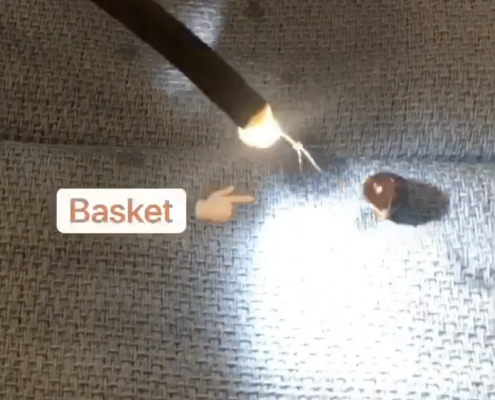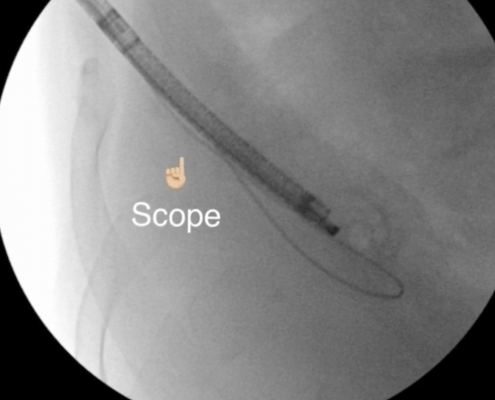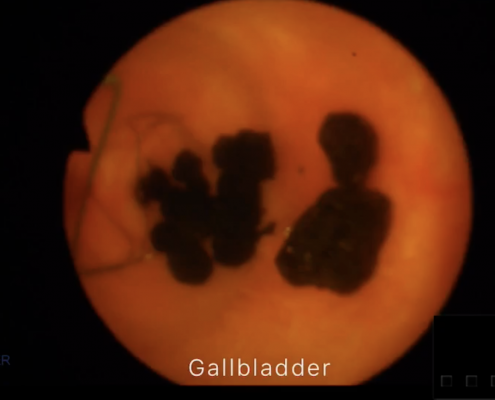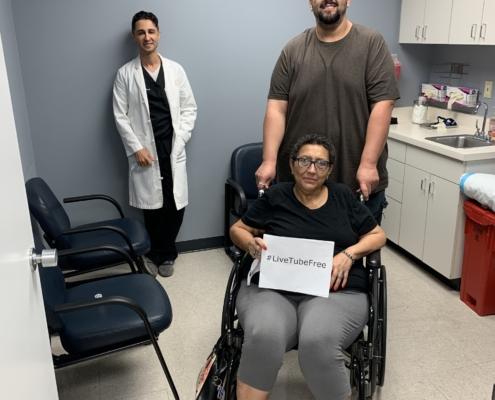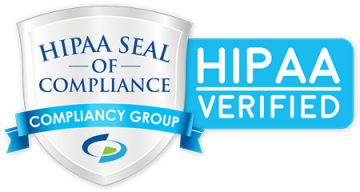Non-Surgical Endoscopic Gallstone Removal
Gallbladder stones, known as cholelithiasis, can be asymptomatic or cause abdominal pain and infection. Gold standard treatment is to remove the gallbladder.
Patients who cannot undergo surgical gallbladder removal, can end up with a tube in their gallbladder called a cholecystostomy. This is not ideal as these tubes have to be changed for life and can become a burden on the family and patient. The cholecystostomy tube cannot be removed because of the risk of recurrent pain and symptoms.
Percutaneous endoscopic gallstone removal is a non-surgical technique that preserves the gallbladder by removing the stones through the tract using different methods. There may also be stones in the bile ducts, known as choledocholithiasis, that can also be removed. This treatment is also starting to be offered to patients who can also have surgery.
The procedure is performed by a specialty trained Board Certified Interventional Radiologists, a medical doctor who is trained doing procedures with the use of X-rays and other advanced imaging to see inside the body and treat conditions without surgery. The Interventional Radiologist uses direct visualization with a small camera and X-ray guidance from a fluoroscopy machine that allows for control of the instruments used to remove the stones.
Candidates for Percutaneous Gallstone Removal
Endoscopic gallstone removal has traditionally been offered to patients who are not able to have traditional gallbladder removal surgery or who have bile duct stones that cannot be removed in the standard fashion. These patients have had symptomatic gallstones that require treatment.
Gallstones can cause pain that is usually on the right side or middle of your upper belly, may be constant or worse after a heavy meal, may sometimes feel more like fullness than pain, may be felt in your back and in the tip of your right shoulder blade. Other symptoms may include nausea, vomiting, fever, and chills. The symptoms of gallbladder problems may look like other health problems. Always see your healthcare provider to be sure.
If you have had a gallbladder drain placed for gallstones but cannot get your gallbladder surgically removed, then you are potentially a candidate for this procedure.
Recently this procedure has also started to be offered to patients who are surgical candidates but for personal, dietary or religious reasons they do not want their gallbladder removed.
Gallstone removal is a safe and effective procedure when performed by an experienced Interventional Radiologist with an understanding of the techniques to reduce complications.
Success Rate of Percutaneous Gallstone Removal
Endoscopic and fluoroscopic-guided gallstone removal is highly successful, with complete stone removal from the gallbladder or bile ducts occurring in 80% of cases. Once the stones are removed from the gallbladder and bile ducts there is no reason for removal of the gallbladder or requiring a drain. Recurrent formation of stones is possible.
Endoscopic Gallstone Removal: Procedure Details
Percutaneous endoscopy is performed through the existing gallbladder drain tract. If you don’t have a gallbladder drain, this will need to be placed.
After 4-6 weeks a tract will form around the gallbladder drain, this is required to prevent any leakage of stones or bile into the abdomen. Once it is confirmed that there is a formed tract, the endoscopic procedure can then be schedule.
Sometimes the size of the drainage catheter is increased prior to removal of the stones so that the tract is larger to accommodate the camera. This depends on the size of the stones.
On the day of the procedure, the drain is exchanged for a larger temporary access into the gallbladder that will fit the endoscopic camera. Iodinated contrast material maybe injected into the bile ducts to locate gallstones that maybe causing blockage. Small stones are removed using a basket that fits through the camera. Other stones can be washed out by irrigating the gallbladder with saline or water.
Larger stones can be fragmented under endoscopic guidance with a precisely directed holmium laser. The gallbladder is filled with sterile water prior to fragmentation as the laser beam is absorbed by water, preventing damage to the gallbladder wall.
On average, it takes two sessions to clear patients of their stones if there is a large stone burden. After the stones are removed, the tube will stay in place for a couple of weeks to ensure the gallbladder/bile system is still intact and functioning normally. Once this is confirmed, the tube is then removed. The tract heals and closes on its own and does not require any suture or surgery.
Preparing for Gallstone Removal Procedure
Prior to the Procedure
You may not eat or drink eight to 12 hours prior to the procedure.
If you are on blood-thinning medication you may be asked to stop it prior to the procedure.
During the Procedure
You will be asked to change into a gown before the procedure.
Labs will be obtained.
You will be given a sedative by the anesthesiologist, who will be present to monitor your vital signs during the examination. Typically the procedure is done with a “twilight sedation.”
After the Procedure
This is an outpatient procedure and does not require hospital stay.
You will remain in a recovery room until most of the effect of the sedative has worn off.
Because of sedation used during the procedure, you’ll need to make plans to have someone take you home.
Gallstone Removal Procedure: Risks
Discomfort at the insertion site
Infection
Nausea
Bleeding
Bile duct or gallbladder injuries like perforation
Gallstone Removal Procedure: Results
The procedure is highly successful in the right candidate. This renders patients tube and gallstone free. Risk of recurrent gallstones is unknown.
The following are x-ray images of the bile ducts, showing a gallbladder with a large stone prior to and following removal by percutaneous cholangioscopy.
This picture shows a gallbladder with a large stone. The arrow points to a smaller drainage catheter that was inserted to relieve pressure.
Following the percutaneous cholangioscopy procedure, the drainage catheter can be removed.
This image shows the gallbladder after the gallstone and drainage catheter’s removal.



